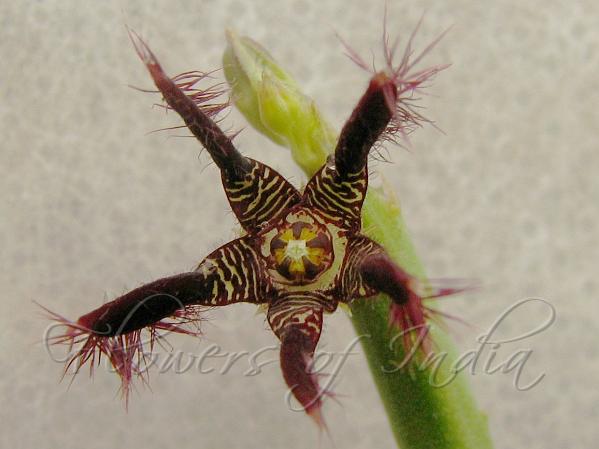|
| Caralluma |
|

|

| File size | 148046 |
| Original date | 7/31/10 2:58 PM |
| Resolution | 1240 x 930 |
| Flash | Flash did not fire, auto |
| Focal length | 6.0mm |
| Exposure time | 1/100s |
| Aperture | 3.5 |
| Focus Distance | |
| Metering Mode | Multi-segment |
| Camera make | Canon |
| Camera model | Canon PowerShot S5 IS |
| Sensor type | OneChipColorArea |
|
|
|
|
Photo: |
Botanical name: Caralluma fimbriata Family: Apocynaceae (Oleander family)
Synonyms: Ceropegia adscendens var. fimbriata
Synonyms: Ceropegia adscendens var. fimbriata
Caralluma is an erect branched herb, 20-30 cm tall. Stems are leafless,
4-angled, fleshy, green, tapering to a point. Leaves are minute, present
only on young branches, soon falling off, leaving a tooth-like projection
on the angles. Flowers are borne at the end of branches, singly or 2-3
together on short stalks. Flowers are like wheels, 2 cm across. Petals are
narrow, purple with yellow marking, and margins frilly with hairs. Fruits
are 10-12 cm long, cylindric with one of the pairs often suppressed. Caralluma is found in peninsular India. It has been eaten in rural India for
centuries, raw, as a vegetable with spices, or preserved in chutneys and
pickles, and is often found as a roadside shrub or boundary marker. It has
been used as a portable food and thirst quencher for hunting. It is also
used for its purported ability to suppress hunger and appetite and enhance
stamina. Tribesmen on a day's hunt will often only pack some Caralluma
to sustain themselves and hence it is commonly considered a "famine food"
in India. Flowering: July-August.
| Identification credit: Prashant Awale | Photographed in Maharashtra. |
• Is this flower misidentified? If yes,